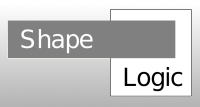
The demand to libraries is that they can compete with ImageJ in both features and simplicity. More specific they need to be:
This page will will give a short description of the libraries and some possible future development.
Boost is a collection of open source C++ libraries, a place where new features of C++ is implemented and tried before becoming part of the C++ standard.
This makes use of some very advanced and new programming techniques e.g.
It contains a lot of functional programming features that should be helpful for the lazy stream library.
Generic Image Library was developed by Adobe but a part of Boost since 1.35. This uses template programming and is written so that you can write an algorithm once and have it be implemented efficiently for many different image types. This is something that you cannot do in ImageJ. The price is that it is programmed with advanced templates.
GIL makes wrappers around other images classes. This works fine with both FLTK images class: Fl_Image and OpenCV images: IplImage.
OpenCV is written by Intel. It is simple to use and comes with a lot of algorithms.
Images are read, written and internally stored as OpenCV images: IplImage. One issue is that this is using BGR byte order opposed to RGB as Fl_Image. After reading and before writing the R and B colors are swapped.
FLTK is light to work with. This is built on top of Windows API or X11. This is currently used as the GUI framework in ShapeLogic C++.
Google C++ Testing Framework is a framework for writing C++ unit tests. Based on the xUnit architecture. It has a strong focus on simplicity and terse code.
Cross platform Make replacement.
OpenFrameworks is a C++ based image processing tool for artists, close to Processing that is written in Java. This is built on top of OpenCV.
Seems to be in a very early stage but people are using it.
Adobe Photoshop would be a full fledged workbench.
PhotoShop is not open source but there should not be any problem when using it as a platform. Since PhotoShop is the standard image manipulation tool, this could be a good way to make ShapeLogic algorithms available to a wider audience.
The PhotoShop API is not freely available, you have to apply to get it.
GIMP - The GNU Image Manipulation Program is an open source drawing program that works with external plugins.
This would be a full fledged workbench.
ShapeLogic cannot be linked to GIMP since it is GPL, but you could have a wrapper around plugins in order to access them as GIMP plugins.
The plugin works with tiles, which gives good performance, but does not fit well with either the way OpenCV or GIL are processing images.
FLTK seems to be the simples cross platform GUI toolkit with an appropriate license, but it is a very sparse library. If at some point a more full featured library is needed here are some alternatives.
Framework for declarative definition of GUI.
Currently only works on Windows and Mac.
It is a relatively big frameworks, where ShapeLogic is trying to be a simple as possible.
GTK is a full featured GUI toolkit working on most platforms.
It is written in C and has a homegrown object system, which is not type safe.
GTKMM is a C++ wrapper around GTK. Programming in GTKMM is a lot more natural to C++ programmers.
The class hierarchy is somewhat deep since it is build on top of GTK. It seems a little heavier than FLTK.
Very lightweight. There is some functionality for displaying images and an event handler for mouse events.
It does not seem to have a menu system, which is essential for a rudimentary workbench.
Qt is a very strong GUI framework with lots of high quality tools. Since 4.5 Qt has been LGPL and therefor compatible with ShapeLogic C++.
Qt is using a lot of Qt specific classes e.g. QString and QList.
Powerful but non standard concept of slot and signal.
wxWidgets is a full featured GUI toolkit, built on top of native toolkits: Win32, Mac OS X, GTK+, X11, Motif, WinCE and more. The programming style is close to Windows MFC programming.
It seems a little heavier than FLTK.